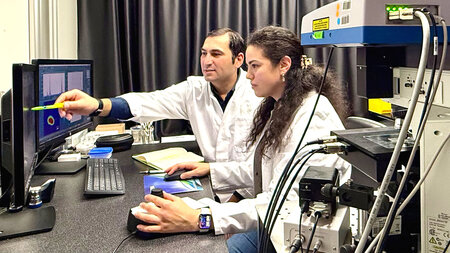A New Form of Chaos is Realized in the Lab
Renowned publication: An international research team including members from Chemnitz confirms their prediction of a new type of chaos – with potential applications in communication technology, cryptography and data processing
-

Prof. Dr. Günter Radons (middle), Dr. Andreas Otto (left) and David Müller are getting to the bottom of chaos at Chemnitz University of Technology. Photo: Jacob Müller -

Dr. Joseph D. Hart and Prof. Rajarshi Roy (not shown) from the University of Maryland have confirmed the prediction of a new type of chaos, which was predicted by Chemnitz researchers in 2018. -

A schematic experimental setup with laser diode, Mach Zehnder modulator, photoreceiver and FPGA (from left to right). Below: A structure of realizable forms of the temporal course of the light intensity. Previously known “Turbulent Chaos” (above) and newly-discovered “Laminar Chaos” (below). Graphics: David Müller-Bender, Andreas Otto and Günter Radons -

Optoelectronic experimental setup at the University of Maryland. In the foreground one sees the FPGA, with which the temporal variation of the delay was implemented. Photo: Rajarshi Roy
Physicists Dr. Joseph D. Hart and Prof. Dr. Rajarshi Roy from the University of Maryland, in cooperation with physicists from Chemnitz University of Technology under the supervision of Prof. Dr. Günter Radons (from the research group Complex Systems and Nonlinear Dynamics), have achieved a milestone in chaos research. In an experiment, the American researchers confirmed the prediction of a new type of chaos. This prediction was made in 2018 by their colleagues in Chemnitz, David Müller-Bender, Dr. Andreas Otto and Prof. Dr. Günter Radons, and already then, it attracted significant international attention.
The Chemnitz physicists found that an inconspicuous modification of a previously known laser experiment with delayed feedback can lead to completely new variations of intensity of the laser light. The researchers called this “laminar chaos”. The required periodic variation of the delay has now been implemented by the American scientists in their experimental setup (see Figure 3), via a so-called “Field Programmable Gate Array” (FPGA), a very fast programmable integrated circuit. In contrast to the previously known chaotic high-frequency oscillations (shown in the upper signal in Figure 3), the predicted sequence of plateaus (shown in the lower signal in Figure 3) was measured. This seemingly orderly sequence is nevertheless chaotic, as plateau heights vary chaotically from plateau to plateau. Since the plateau structure is rather insensitive to disturbances and the plateau height can be arbitrarily modified, this signal form is suitable for use as information carrier.
In a recent publication in the internationally renowned journal “Physical Review Letters”, the Chemnitz physicists and their colleagues from Maryland reported on the experimental realization of laminar chaos and its robustness against perturbations. The findings open up new applications in modern information technologies. Thus, the electro-optical experimental setup might be a first step towards the use of laminar chaos in fast optical realizations of secure communication, as it can take advantage of the poor predictability of chaotic dynamics (chaos communication and chaos cryptography) and reservoir computing.
Background: Chaos & Delay
In physics, the term “chaos” refers to a form of movement that appears to be very irregular, but still follows clear laws. Almost all systems have this characteristic, which makes long-term predictions impossible. Well-known examples in everyday life include the weather or the drawing of lottery numbers. However, even laser light or the size of bacterial colonies can behave chaotically.
“Delay” is a technical term that describes the delay time between cause and effect. In many cases this cannot be neglected and can cause extremely complicated forms of motion.
Original publication in “Physical Review Letters”:
J. D. Hart, R. Roy, D. Müller-Bender, A. Otto and G. Radons: Laminar Chaos in Experiments: Nonlinear Systems with Time-Varying Delays and Noise, Phys. Rev. Lett. 123, 154101 (2019). Online verfügbar: doi.org/10.1103/PhysRevLett.123.154101
(Article: Matthias Fejes / Translation Translation: Jeffrey Karnitz)
Matthias Fejes
30.10.2019




